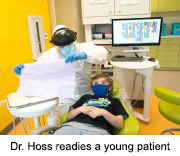TUESDAY, June 16, 2020 (HealthDay News) — Dental offices responded to COVID-19 lockdowns in much the same way as other medical professions, halting routine visits and only providing emergency care to patients in dire need.
But now that stay-at-home orders are lifting, many dentists are reopening, but with new protocols to limit infection.
Your dental appointment will not be the same, with changes from the waiting room to the dental chair, dentists say.
First off, don’t expect to spend a lot of time lounging in the waiting room, flicking through old magazines.
Many dentists are asking patients to instead wait in their car until their treatment chair inside is ready. Patients text or call to let the office know they’re outside, and use a phone or tablet to fill out paperwork, said Dr. Kami Hoss, an orthodontist in San Diego.
“Our waiting room now starts in the car. We’ve virtualized the waiting room,” he said.
Once inside, patients will be greeted at a screening table where assistants will ask about COVID-19 symptoms and take their temperature, said Dr. Kirk Norbo, co-chairman of an American Dental Association task force that developed a guide to reopening dental offices.
“We’re pretty thorough on the whole screening process at this point,” said Norbo, a dentist in Purcellville, Va.
These screening procedures should make a dental office one of the safest places in medicine to seek treatment, according to Hoss.
“Our goal is to keep this virus outside of our office,” he said. “If a patient has any symptoms that could be a red flag, we reschedule and postpone their appointment.”
You’ll be asked to wear a mask all the way through the office, removing it only when you’ve settled in the dental chair.
You might also notice fewer people in the office. Practices are trying to space out appointments to minimize the number of folks in the building at any given time, Norbo said.
Patients are also being asked to limit the number of people they bring to an appointment. That could mean that parents leave their kids at home with a babysitter, or that parents of older kids might be asked to wait outside while their child is treated, Hoss said.
Dentists will use text or video messaging to communicate what treatment a child is receiving and what the parent needs to know about aftercare, Hoss said.
Once you’re in the chair, many things will look much the same, because dentistry has long focused on infection control to prevent the spread of H1N1 flu, HIV and other dangerous pathogens, Norbo said.
But you are liable to see your dentist and hygienist more fully decked out in personal protective equipment.
“They’re going to see more of that ‘Star Wars’ look,” with staff wearing gowns and face shields and masks, Norbo said.
There also will be some changes in procedure specifically designed to prevent the spread of a respiratory bug like SARS-CoV-2, the new coronavirus that causes COVID-19.
For example, San Francisco-based dentist Dr. Nammy Patel gives her patients a mouthwash containing hydrogen peroxide and salt to kill off any germs that might be lingering in their mouths.
“It’s been documented that the coronavirus is killed by peroxide and saline,” she said.
Don’t expect to be asked to spit, either. Patel said she suctions out the mouthwash, as well as any saliva or water that might build up in your mouth during cleaning or dental work.
“We don’t even give them the opportunity to spit,” she said.
Patel also has invested in an additional vacuum device that remains about 2 feet from the patient’s face to suck up any droplets that might fly out of the mouth.
“There are a lot of unknowns when it comes to COVID,” Patel said. “I’d rather be the helicopter mom and overdo it rather than underdo it.”
Dentists and hygienists working with a patient are being encouraged to choose methods that will reduce the amount of aerosol coming from the mouth as well, Hoss said.
Instead of drilling, a dentist might use chemicals and instruments to remove composite material, he said. Hygienists will use traditional metal hand instruments to remove plaque, rather than newfangled ultrasonic cleaners that tend to create a lot of spray.
Just remember that if you’re trying to see your dentist and you don’t have an appointment, it might be a while before you’re able to get in.
People who missed their cleanings during the two months of lockdown are now trying to reschedule. That, on top of folks already scheduled for dental work and the need to space out dental appointments, is creating a bit of a logjam in some offices, Norbo said.
“I’m amazed at the rebound of the patients,” he said. “We’re slammed right now. We’re getting booked up like it’s pre-COVID days.”
More information
The American Dental Association has more about dentists reopening their offices.
Copyright © 2025 HealthDay. All rights reserved.

